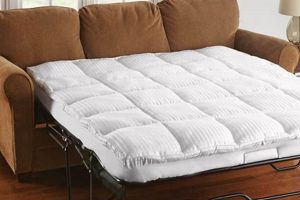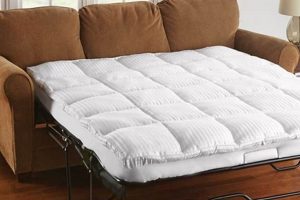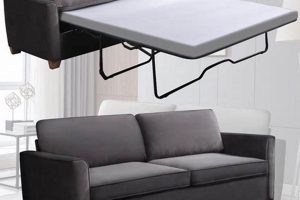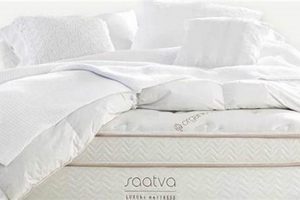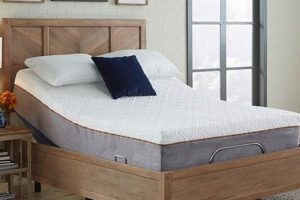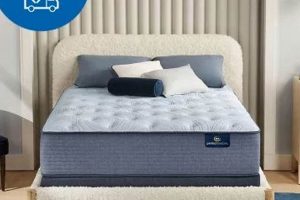Prolonged use of inflatable beds can present several potential problems. These include inadequate support leading to musculoskeletal issues, temperature regulation difficulties potentially causing discomfort, and the presence of phthalates in certain materials raising concerns about chemical exposure.
Understanding the potential adverse effects is essential for informed decision-making regarding sleep surfaces. Choosing appropriate bedding options contributes to improved sleep quality and long-term physical well-being. Consideration of these factors is especially relevant for individuals with pre-existing health conditions or those requiring specific orthopedic support.
The subsequent sections will delve into specific risks associated with relying solely on this type of bedding, examine preventative measures, and outline alternative sleep solutions that promote healthier rest.
Mitigating Potential Adverse Effects
To minimize potential issues, consider implementing specific strategies when utilizing an inflatable sleeping surface.
Tip 1: Employ Supplemental Support: Augment the mattress with a firm foundation or place it on a supportive surface. This reduces sagging and promotes better spinal alignment.
Tip 2: Regulate Temperature: Use appropriate bedding layers to manage temperature effectively. A mattress topper can improve insulation, while breathable sheets enhance ventilation.
Tip 3: Rotate Regularly: Shift sleeping positions frequently to alleviate pressure points. This simple adjustment can prevent localized discomfort.
Tip 4: Monitor Inflation Levels: Ensure the mattress maintains optimal inflation. Avoid over or under-inflation, as both can compromise support and comfort.
Tip 5: Limit Prolonged Usage: Refrain from using an air mattress as a primary long-term sleep solution. Explore alternative, more supportive bedding options for extended use.
Tip 6: Research Material Composition: Opt for models manufactured with materials certified as low-emission and free from harmful chemicals. Prioritize products with verifiable safety standards.
Tip 7: Consult Healthcare Professionals: Individuals with pre-existing back problems or musculoskeletal issues should seek guidance from a medical professional regarding appropriate sleep surfaces.
Implementing these preventative measures can substantially reduce the probability of experiencing adverse effects associated with reliance on this kind of mattress.
The following sections will examine alternative sleep solutions that prioritize long-term comfort and orthopedic well-being.
1. Spinal Misalignment
Prolonged use of an air mattress can contribute to spinal misalignment due to the uneven distribution of support and the tendency of these mattresses to sag or conform excessively to body weight. This lack of consistent support compromises the natural curvature of the spine, leading to discomfort and potentially exacerbating pre-existing musculoskeletal conditions. Unlike traditional mattresses with internal coil or foam structures providing uniform support, air mattresses offer a variable and often unstable surface.
Consider, for example, an individual with a history of lower back pain who regularly uses an air mattress while traveling. The inadequate support can lead to increased pressure on spinal discs and muscles, resulting in intensified pain and stiffness. Furthermore, the absence of proper spinal alignment during sleep can hinder the body’s natural recovery processes, potentially leading to chronic issues. The practical significance of understanding this connection lies in the ability to make informed decisions about sleep surfaces, particularly for those with specific orthopedic needs.
In summary, the risk of spinal misalignment represents a significant component of the broader health concerns associated with consistent air mattress use. By recognizing the potential for inadequate support and its impact on spinal health, individuals can take preventative measures or opt for more appropriate bedding solutions that promote optimal spinal alignment and long-term well-being.
2. Temperature Fluctuations
Temperature instability represents a notable concern when considering the suitability of air mattresses for regular sleep. The inherent design and material composition of these mattresses contribute to challenges in maintaining a consistent and comfortable thermal environment, potentially disrupting sleep quality and overall well-being.
- Limited Insulation Properties
Air mattresses, by their nature, possess minimal insulating capabilities. The air-filled chamber conducts heat readily, resulting in heat loss during colder periods and heat retention in warmer conditions. This lack of thermal regulation can lead to discomfort and sleep disturbances, as the body struggles to maintain a stable core temperature throughout the night. A person using an air mattress in a poorly insulated room during winter, for instance, might experience significant heat loss, leading to shivering and fragmented sleep.
- Condensation Formation
The temperature differential between the sleeper’s body and the air within the mattress can lead to condensation formation, particularly in humid environments. This moisture accumulation can create a damp sleeping surface, fostering mold and mildew growth over time, which poses a health risk to individuals with allergies or respiratory sensitivities. Consider a scenario where an air mattress is used in a camping setting; the combination of cooler nighttime temperatures and high humidity increases the likelihood of condensation forming within the mattress.
- Material Response to Temperature
The plastic or vinyl materials commonly used in the construction of air mattresses can become stiff and uncomfortable in cold temperatures, while expanding and becoming excessively pliable in hot environments. This material instability compromises the support and comfort provided by the mattress, further impacting sleep quality. An air mattress exposed to direct sunlight, for example, might become overly soft and lose its structural integrity, detracting from its ability to provide adequate support.
The interplay of these factors emphasizes the role of temperature instability as a potential drawback of relying on air mattresses. Individuals considering the long-term use of such mattresses should carefully assess the environmental conditions and implement strategies to mitigate these effects, such as using insulating mattress toppers or controlling the ambient temperature of the sleeping environment. Failure to address these issues can lead to diminished sleep quality and potential health concerns.
3. Material Off-gassing
Material off-gassing, a chemical process whereby volatile organic compounds (VOCs) are released from synthetic materials, constitutes a significant element of the hazards associated with sleeping on an air mattress. Air mattresses, often constructed from polyvinyl chloride (PVC) or similar plastics, contain plasticizers, stabilizers, and other additives that can gradually emit into the surrounding air. This emission process is exacerbated by temperature and humidity, common factors within a sleeping environment, accelerating the release of these chemicals. The inhalation of VOCs can trigger a range of adverse health effects, varying in severity depending on the individual’s sensitivity and the concentration and type of chemicals released. Formaldehyde, phthalates, and other organic solvents are common components that can be off-gassed. A newly purchased air mattress, for instance, often exhibits a distinct chemical odor, representing a period of heightened off-gassing that can cause respiratory irritation, headaches, or nausea, particularly in enclosed spaces with poor ventilation. Prolonged exposure to these chemicals, even at low concentrations, may contribute to long-term health problems.
The impact of material off-gassing is further amplified by the close proximity of the sleeper to the emitting source throughout the night. This extended exposure allows for continuous inhalation of VOCs, potentially affecting respiratory function and overall well-being. Individuals with pre-existing respiratory conditions, such as asthma or chemical sensitivities, are particularly vulnerable to the adverse effects. Consider the scenario of a child sleeping regularly on an air mattress in a bedroom with limited airflow; the cumulative exposure to VOCs could compromise their developing respiratory system. Moreover, certain flame retardants, frequently incorporated into the materials of air mattresses, are known to be endocrine disruptors, potentially interfering with hormonal balance. Consequently, understanding the composition and off-gassing potential of air mattress materials is essential for mitigating these risks. Opting for air mattresses made from materials certified as low-VOC or incorporating strategies to improve ventilation can minimize the exposure to harmful chemicals.
In summary, material off-gassing represents a crucial component of the dangers associated with sleeping on an air mattress, primarily due to the potential for inhaling harmful VOCs released from synthetic materials. The severity of the impact varies based on individual sensitivity, chemical concentration, and duration of exposure. Addressing this concern necessitates informed decision-making regarding material selection, ventilation practices, and limiting prolonged usage, all of which are vital for minimizing health risks associated with this sleep surface. Further investigation into alternative, low-emission materials and enhanced ventilation strategies is warranted to mitigate the off-gassing-related concerns associated with air mattresses.
4. Pressure point aggravation
Air mattresses, owing to their construction, frequently exhibit uneven weight distribution, leading to increased pressure on specific areas of the body. This localized pressure, particularly around bony prominences such as hips, shoulders, and knees, can result in significant discomfort and contribute to the development or exacerbation of pressure points. Unlike traditional mattresses that conform more uniformly to the body’s contours, air mattresses can create areas of concentrated pressure due to variations in air inflation and the lack of consistent support across the sleep surface. For example, an individual with a slender build may experience heightened pressure on their hip bones when sleeping on an air mattress, as the air chamber fails to provide adequate cushioning in that area. This increased pressure impedes blood flow, potentially causing numbness, tingling, and pain. The practical significance of acknowledging this connection lies in recognizing the need for supplementary measures to alleviate pressure points, such as the use of a supportive mattress topper or strategic placement of pillows. Ignoring this aspect can result in disrupted sleep, chronic discomfort, and potentially contribute to the development of more serious musculoskeletal issues.
The severity of pressure point aggravation is influenced by several factors, including the individual’s weight, sleeping position, and the degree of inflation in the air mattress. Those who sleep on their side are particularly vulnerable to pressure buildup on their hips and shoulders, while individuals who are overweight may experience increased pressure across a broader surface area. The level of inflation also plays a crucial role; an under-inflated air mattress offers insufficient support, causing the body to sink excessively, thereby increasing pressure on contact points. Conversely, an over-inflated mattress may feel too firm and unyielding, intensifying pressure on bony areas. Furthermore, individuals with underlying health conditions such as arthritis or fibromyalgia may find that pressure point aggravation exacerbates their existing pain and discomfort. For instance, a person with arthritis in their hips may experience increased joint pain and stiffness after sleeping on an air mattress due to the lack of conforming support and uneven pressure distribution.
In summary, pressure point aggravation constitutes a tangible element of the risks associated with using air mattresses, stemming from their inherent design and potential for uneven weight distribution. The consequences of this aggravation extend beyond mere discomfort, potentially contributing to disrupted sleep, chronic pain, and exacerbation of underlying health conditions. By understanding the underlying mechanisms and contributing factors, individuals can implement preventative measures to mitigate pressure points or opt for more suitable sleep surfaces that offer consistent and conforming support, thus promoting improved sleep quality and overall well-being. Therefore, careful consideration of pressure point aggravation is essential when evaluating the suitability of air mattresses as a sleep solution, particularly for individuals with specific orthopedic needs or pre-existing health conditions.
5. Insufficient Support
Inadequate support constitutes a primary factor contributing to the potential detriments associated with the prolonged or habitual use of air mattresses. The inherent design characteristics of these inflatable surfaces often fail to provide the consistent, anatomically correct support necessary for maintaining spinal alignment and promoting healthy sleep posture.
- Compromised Spinal Alignment
Air mattresses can lack the structural integrity needed to maintain proper spinal curvature during sleep. The yielding nature of the air chamber allows the body to sink unevenly, leading to spinal misalignment. Over time, this can exacerbate existing back problems or contribute to the development of new musculoskeletal issues. For instance, an individual with a pre-existing lumbar disc issue may experience increased pain and discomfort due to the lack of proper lumbar support.
- Uneven Weight Distribution
The absence of a consistent support system within the mattress results in uneven distribution of body weight. This can lead to concentrated pressure on certain areas, such as the hips and shoulders, potentially causing discomfort, numbness, or even pressure sores with prolonged use. A person with a larger frame, for instance, may find that an air mattress offers insufficient support in the mid-section, leading to a hammock-like sleeping position and subsequent back strain.
- Lack of Motion Isolation
Air mattresses typically exhibit poor motion isolation, meaning that movement on one side of the mattress is readily transferred to the other side. This can be particularly disruptive for couples, as each partner’s movements can disturb the other’s sleep. For example, a light sleeper sharing an air mattress with a restless partner may experience frequent awakenings due to the lack of motion dampening.
- Inadequate Edge Support
Many air mattresses lack sufficient edge support, making it difficult to sit comfortably on the edge of the bed or preventing individuals from fully utilizing the sleeping surface. This limitation can be problematic for those with mobility issues or those who prefer to sleep near the edge of the bed. A person with limited mobility may find it challenging to get in and out of bed if the air mattress lacks a firm edge for support.
The cumulative effect of these facets of insufficient support underscores the potential negative consequences of relying on air mattresses as a primary or long-term sleep solution. The compromised spinal alignment, uneven weight distribution, lack of motion isolation, and inadequate edge support can contribute to discomfort, sleep disruption, and the development of musculoskeletal problems. While air mattresses may serve as a temporary or occasional solution, individuals seeking sustained comfort and orthopedic support are advised to consider alternative bedding options that provide more consistent and anatomically sound support.
6. Durability concerns
The limited lifespan and susceptibility to damage inherent in air mattresses significantly contribute to the potential hazards associated with their long-term use. Reduced durability can lead to compromised support, instability, and potential health risks over time.
- Puncture Vulnerability
Air mattresses are susceptible to punctures from sharp objects, pets, or even wear and tear over time. A puncture can lead to rapid deflation, causing a sudden loss of support and potentially resulting in injury or discomfort. For instance, a small tear unnoticed could lead to a complete deflation during sleep, causing a sudden jolt and potential back strain. The implications extend to a disrupted sleep cycle and possible physical harm.
- Seam Weakness and Air Leakage
The seams of an air mattress are often the weakest points, prone to developing leaks or tears with repeated use and pressure. Gradual air leakage can result in a loss of firmness and support, leading to spinal misalignment and discomfort. An example is a slow leak developing at a seam that goes unnoticed until significant sagging occurs, leading to chronic back pain. This gradual degradation undermines the mattress’s intended function.
- Material Degradation
The materials used in air mattress construction, such as PVC or similar plastics, can degrade over time due to exposure to temperature fluctuations, UV light, and body oils. This degradation can lead to the material becoming brittle, cracked, or losing its elasticity, compromising the mattress’s structural integrity and comfort. Prolonged exposure to sunlight, for example, can cause the plastic to harden and crack, reducing its ability to conform to the body and increasing the risk of tears. Material breakdown contributes to diminished performance and potential health hazards.
- Pump and Valve Failure
Air mattresses often rely on integrated pumps or valves for inflation and deflation. These components are susceptible to mechanical failure, such as motor burnout, valve leakage, or clogging. A malfunctioning pump or valve can render the mattress unusable or result in inconsistent inflation levels, affecting its comfort and support. A pump that fails unexpectedly before a trip, leaving users without a bed, is a practical example. Component failure directly impacts usability and overall satisfaction.
In conclusion, durability concerns are integrally linked to the overall risks of relying on air mattresses, where the potential for punctures, leaks, material degradation, and component failure can lead to compromised support, discomfort, and potential health issues, highlighting the limitations for consistent, long-term use.
7. Allergen accumulation
Allergen accumulation in air mattresses presents a significant yet often overlooked aspect of the potential health risks associated with their use, particularly in the context of long-term or habitual reliance on these sleep surfaces. The materials and construction of air mattresses create an environment conducive to the proliferation and retention of various allergens, posing a threat to individuals with sensitivities or respiratory conditions.
- Dust Mite Proliferation
Air mattresses, with their fabric or flocked surfaces, offer an ideal habitat for dust mites. These microscopic organisms thrive in warm, humid environments and feed on dead skin cells shed by humans. The accumulation of dust mite feces and body fragments within the mattress can trigger allergic reactions in susceptible individuals, including symptoms such as sneezing, runny nose, itchy eyes, and asthma exacerbations. Consider the situation of an individual with dust mite allergies who uses an air mattress as their primary sleeping surface; they are likely to experience persistent allergic symptoms due to the constant exposure to these allergens.
- Mold and Mildew Growth
The air-filled interior of air mattresses can trap moisture, creating a breeding ground for mold and mildew. Condensation, spills, or even humidity from the surrounding environment can penetrate the mattress and foster the growth of these fungi. Mold and mildew spores released into the air can trigger allergic reactions and respiratory problems, especially in individuals with asthma or compromised immune systems. For example, an air mattress stored in a damp basement or used frequently in humid climates is prone to mold and mildew growth, posing a health hazard to those who sleep on it.
- Pet Dander Retention
Households with pets often face the challenge of managing pet dander, which consists of microscopic skin flakes shed by animals. Air mattresses can readily accumulate pet dander, particularly if pets are allowed to sleep on or near the mattress. Pet dander is a potent allergen that can trigger allergic reactions in sensitive individuals, leading to symptoms such as skin rashes, hives, and respiratory distress. Imagine a household with cats or dogs where an air mattress is used as a guest bed; visitors with pet allergies may experience significant discomfort and allergic symptoms due to the accumulated pet dander.
- Limited Cleanability
The design and materials of air mattresses often make them difficult to clean thoroughly. Unlike traditional mattresses, air mattresses cannot be easily vacuumed or spot-cleaned, allowing allergens to persist and accumulate over time. The crevices and seams provide refuge for dust mites, mold spores, and pet dander, making it challenging to eliminate these allergens effectively. An air mattress used frequently but rarely cleaned becomes a reservoir of allergens, constantly exposing the sleeper to potential triggers.
The multifaceted problem of allergen accumulation within air mattresses reinforces the concerns regarding their suitability as a consistent sleep solution. The combined effects of dust mite proliferation, mold and mildew growth, pet dander retention, and limited cleanability create a potentially hazardous environment for individuals with allergies or respiratory sensitivities. Addressing these allergen-related concerns requires careful consideration of mattress materials, regular cleaning practices, and the implementation of allergen-reduction strategies within the sleeping environment. Ultimately, prioritizing allergen control is crucial for mitigating the health risks associated with air mattress use, particularly for vulnerable populations.
Frequently Asked Questions
The following questions and answers address common concerns regarding the safety and suitability of air mattresses as long-term sleep solutions.
Question 1: Is regular use of an air mattress detrimental to spinal health?
Consistent use of an air mattress may contribute to spinal misalignment due to inadequate support and uneven weight distribution. This can exacerbate pre-existing back problems or lead to new musculoskeletal issues over time.
Question 2: What are the potential respiratory concerns associated with air mattresses?
Air mattresses can accumulate dust mites, mold, and other allergens, potentially triggering allergic reactions and respiratory problems. Additionally, some materials used in their construction may off-gas volatile organic compounds (VOCs), which can irritate the respiratory system.
Question 3: Do air mattresses provide adequate support for side sleepers?
Air mattresses often lack the necessary support to maintain proper spinal alignment for side sleepers. The uneven weight distribution can lead to pressure points on the hips and shoulders, causing discomfort and potentially disrupting sleep.
Question 4: Can air mattresses cause temperature regulation problems?
Air mattresses typically lack adequate insulation, which can lead to temperature fluctuations during the night. They can become cold in cooler environments and retain heat in warmer conditions, potentially disrupting sleep quality.
Question 5: Are all air mattresses equally prone to punctures and leaks?
The durability of an air mattress depends on the quality of materials and construction. However, all air mattresses are inherently vulnerable to punctures and leaks, which can lead to a sudden loss of support and potential injury.
Question 6: Are there alternatives to air mattresses that provide better support and comfort?
Numerous alternatives offer superior support and comfort, including memory foam mattresses, innerspring mattresses, and hybrid mattresses. These options are designed to promote proper spinal alignment, distribute weight evenly, and minimize pressure points.
In summary, prolonged or habitual use of air mattresses can pose several health and comfort risks. Individuals seeking a reliable and supportive sleep surface should carefully consider these factors and explore alternative bedding options.
The subsequent section will provide recommendations for selecting appropriate sleep surfaces and optimizing sleep hygiene for improved well-being.
Conclusion
This exploration has illuminated significant concerns related to the sustained use of air mattresses. These inflatable beds, while convenient for temporary needs, present several potential drawbacks when employed as a long-term sleep solution. Key issues identified encompass spinal misalignment stemming from inadequate support, temperature instability leading to disrupted sleep cycles, material off-gassing potentially exposing individuals to volatile organic compounds, pressure point aggravation causing discomfort and musculoskeletal issues, and the accumulation of allergens exacerbating respiratory conditions. These factors collectively undermine the prospect of restorative sleep and may contribute to the development of chronic health problems.
Given the multifaceted nature of these risks, a discerning approach to sleep surface selection is imperative. Individuals are encouraged to prioritize bedding options that offer consistent support, promote proper spinal alignment, and minimize exposure to potential irritants. Consulting with healthcare professionals and conducting thorough research into alternative sleep solutions is strongly advised to safeguard long-term health and well-being. The choice of sleep surface is a critical determinant of physical comfort and overall health, warranting careful consideration and informed decision-making.


